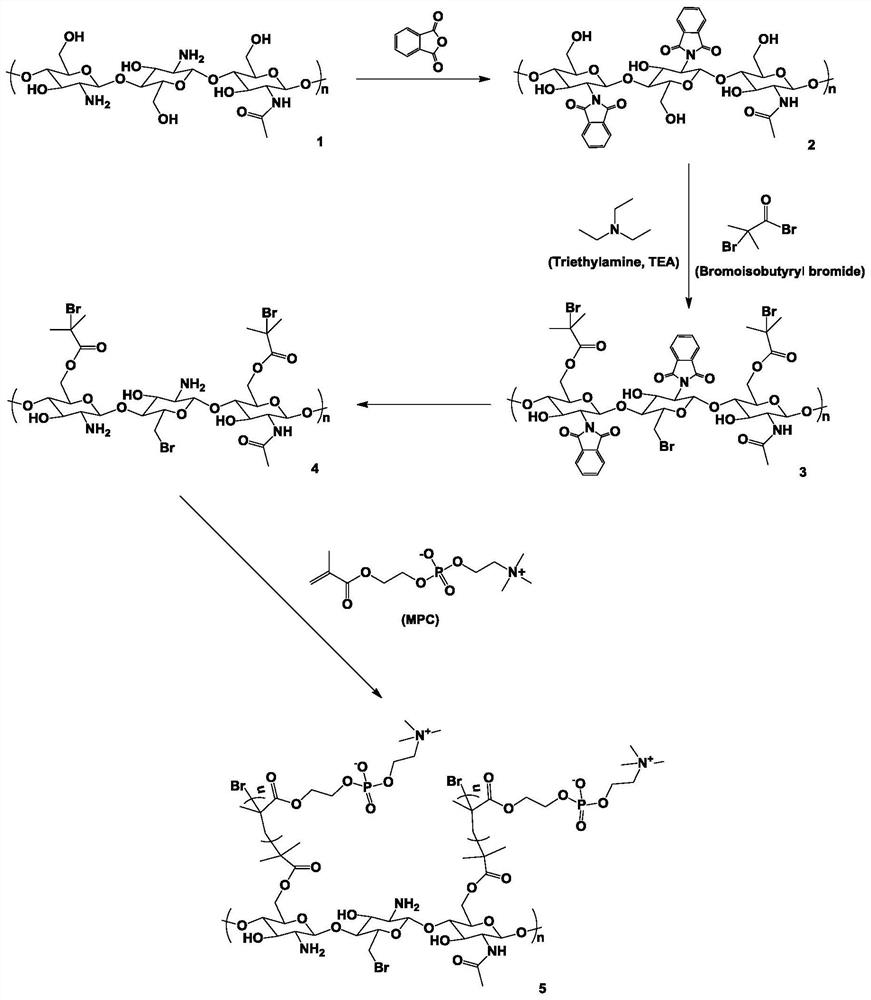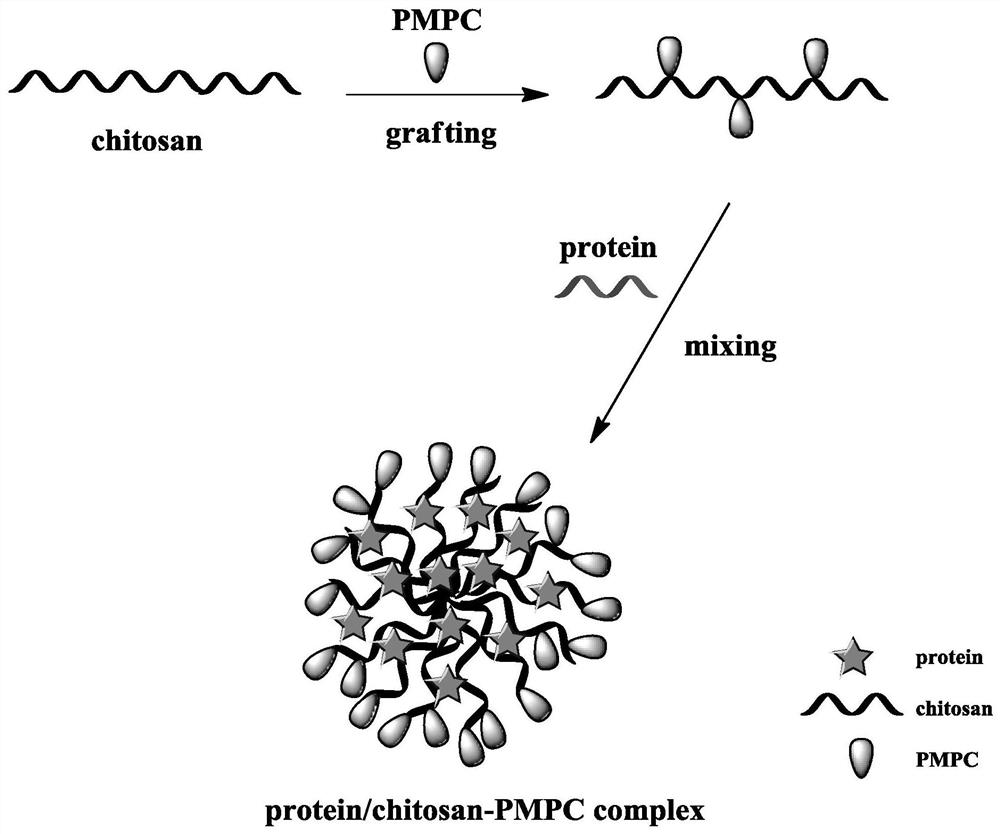A protein carrier for cell transfection
A protein and carrier technology, applied in the field of protein carrier for cell transfection, can solve the problems of high toxicity and limited transfection efficiency, and achieve the effects of enhanced stability, excellent targeting function, good biocompatibility and degradability
- Summary
- Abstract
- Description
- Claims
- Application Information
AI Technical Summary
Problems solved by technology
Method used
Image
Examples
Embodiment 1
[0024] The preparation of embodiment 1 chitosan and poly(2-methacryloyloxyethyl phosphorylcholine) graft (Chi-PMPC-1):
[0025] (1) Preparation of N-phthaloyl-chitosan ((NP-Chi))
[0026] Chitosan (1.0g, 6.20mmol) and phthalic anhydride (2.76g, 18.60mmol) were dispersed in 30ml of DMF containing 5% (v / v), stirred and heated to 120°C under an argon atmosphere . After reacting for 8 hours, it was cooled to room temperature, poured into ice water, and the precipitate was obtained by suction filtration, washed thoroughly with ice methanol, and dried to obtain NP-Chi.
[0027] (2) Preparation of N-phthaloyl-chitosan ATRP macroinitiator (NP-Chi-Br)
[0028] Dissolve N-phthaloyl-chitosan (5.0g) in 30mL DMSO, add 2-bromoisobutyryl bromide (1.0mL) and triethylamine (1.1mL), and stir the reaction at room temperature for 3d After dialysis, filtration, washing and drying, a yellow solid product was obtained, namely NP-Chi-Br.
[0029] (3) Preparation of chitosan ATRP macroinitiator (C...
Embodiment 2
[0033] The preparation of embodiment 2 chitosan and poly(2-methacryloyloxyethyl phosphorylcholine) graft (Chi-PMPC-2)
[0034] (1) Preparation of N-phthaloyl-chitosan (NP-Chi)
[0035] Chitosan (1.0g, 6.20mmol) and phthalic anhydride (2.76g, 18.60mmol) were dispersed in 30ml of DMF containing 5% (v / v), stirred and heated to 120°C under an argon atmosphere . After reacting for 8 hours, it was cooled to room temperature, poured into ice water, and the precipitate was obtained by suction filtration, washed thoroughly with ice methanol, and dried to obtain NP-Chi.
[0036] (2) Preparation of N-phthaloyl-chitosan ATRP macroinitiator (NP-Chi-Br)
[0037] Dissolve N-phthaloyl-chitosan (5.0g) in 30mL DMSO, add 2-bromoisobutyryl bromide (1.0mL) and triethylamine (1.1mL), and stir the reaction at room temperature for 3d After dialysis, filtration, washing and drying, a yellow solid product was obtained, namely NP-Chi-Br.
[0038] (3) Preparation of chitosan ATRP macroinitiator (Chi-...
Embodiment 3
[0042] The preparation of embodiment 3 chitosan and poly(2-methacryloyloxyethyl phosphorylcholine) graft (Chi-PMPC-3):
[0043] (1) Preparation of N-phthaloyl-chitosan (NP-Chi)
[0044] Chitosan (1.0g, 6.20mmol) and phthalic anhydride (2.76g, 18.60mmol) were dispersed in 30ml of DMF containing 5% (v / v), stirred and heated to 120°C under an argon atmosphere . After reacting for 8 hours, it was cooled to room temperature, poured into ice water, and the precipitate was obtained by suction filtration, washed thoroughly with ice methanol, and dried to obtain NP-Chi.
[0045] (2) Preparation of N-phthaloyl-chitosan ATRP macroinitiator (NP-Chi-Br)
[0046] Dissolve N-phthaloyl-chitosan (5.0g) in 30mL DMSO, add 2-bromoisobutyryl bromide (1.0mL) and triethylamine (1.1mL), and stir the reaction at room temperature for 3d After dialysis, filtration, washing and drying, a yellow solid product was obtained, namely NP-Chi-Br.
[0047] (3) Preparation of chitosan ATRP macroinitiator (Chi...
PUM
 Login to View More
Login to View More Abstract
Description
Claims
Application Information
 Login to View More
Login to View More - R&D
- Intellectual Property
- Life Sciences
- Materials
- Tech Scout
- Unparalleled Data Quality
- Higher Quality Content
- 60% Fewer Hallucinations
Browse by: Latest US Patents, China's latest patents, Technical Efficacy Thesaurus, Application Domain, Technology Topic, Popular Technical Reports.
© 2025 PatSnap. All rights reserved.Legal|Privacy policy|Modern Slavery Act Transparency Statement|Sitemap|About US| Contact US: help@patsnap.com


